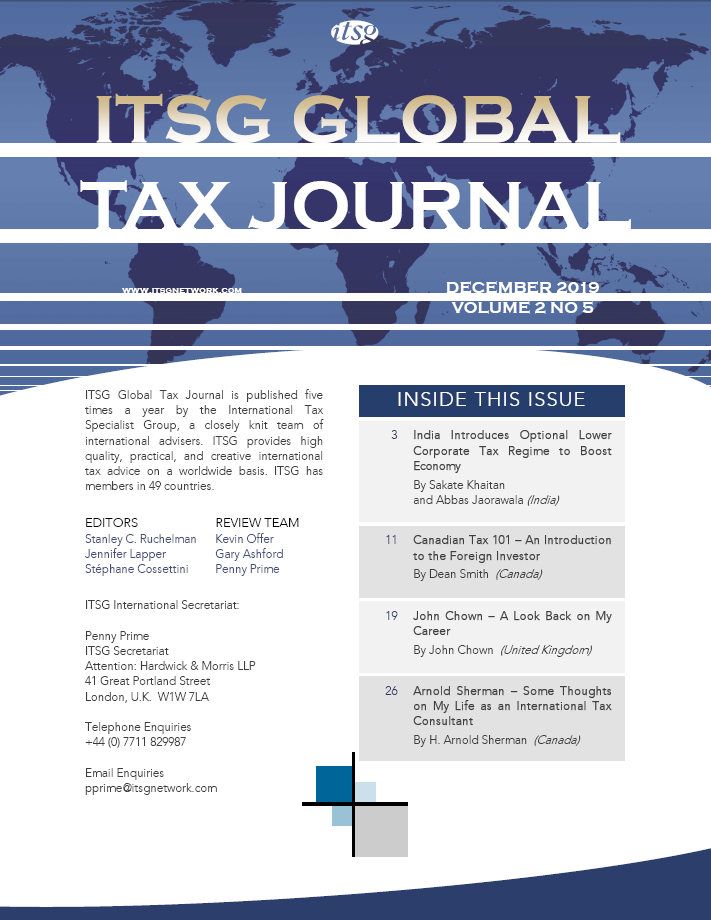India has historically been known as a high-tax jurisdiction for corporations. However, since 1991, the government has worked to improve the corporate tax regime with a goal of enticing investment and promoting industry. A series of measures introduced in September 2019 is the latest step seeking to make Indian companies more attractive for both domestic and international investors. Major parts of this effort involve the enactment of special optional regimes that result in lower taxes and a general reduction in corporate tax rates.
BACKGROUND: INDIA’S CORPORATE TAX PROVISIONS
Prior to economic liberalisation in 1991, the base corporate tax rate for a domestic Indian company was as high as 50%. Over a period of time, the Income-Tax Act, 1961 (the Act) has brought down the base corporate tax rate for Indian companies to 30%. However, the effective tax rate is higher due to applicability of a surcharge and education cess – in the last decade, the effective tax rates for Indian companies have broadly been in the range of 31% to 35% depending on their level of taxable income.
Actual tax payments of Indian companies often do not reflect the headline rate of tax, as various tax holidays, exemptions, and deductions are available based on the activity or the geographical area where activities are undertaken. To ensure that companies with low or nil taxable income based on tax exemptions or special deductions pay some tax, a Minimum Alternate Tax1 (M.A.T.) rate of 18.5%, exclusive of surcharge and cess, is applied to book profits when the M.A.T. yields greater tax than the amount due under normal corporate income tax provisions. The excess of M.A.T. over the normal tax calculation can be offset in future years where tax under the normal provisions is higher than M.A.T.2 This offset amount is popularly known as M.A.T. Credit.
However, the total tax payable by companies and their shareholders is not limited to the normal corporate tax or M.A.T., if applicable. Additional taxes are payable once profits are distributed to shareholders as explained below:
- An Indian company declaring or distributing a dividend is required to pay Dividend Distribution Tax (D.D.T.) at an effective rate of 20.56%3.
- While a dividend is tax-free in the hands of the non-resident shareholders, Indian-resident shareholders other than companies and approved or charitable institutions are required to pay an additional dividend income tax of 10% exclusive of surcharge and cess, for dividends in excess of I.N.R. 1 million4.
Even without considering the additional dividend income tax in the hands of resident shareholders, the total tax paid by Indian companies on profits distributed to shareholders ranges from approximately 41% to 46%, depending on the facts and circumstances.
REDUCING THE CORPORATE TAX RATE
As corporate tax rates across the globe have decreased and other jurisdictions have emerged as less expensive alternates to India for conducting business, India reassessed its corporate tax rates and regimes in order to stay competitive.
Comparatively, the current corporate tax rates in certain relevant jurisdictions are as under:
| Country | Corporate tax rate |
| United States of America | 21% |
| United Kingdom | 19% |
| China | 25% (special rates of 10%, 15%, and 20% are available to certain small businesses and businesses focussed on high technology) |
| Thailand | 20% (lower tax rates apply to small companies) |
| Vietnam | 20% |
The Indian Finance Minister publicly acknowledged the need for lower corporate taxes while presenting his government’s first full-fledged Union budget in February 2015. He stated that the reduction was required to complement the overhaul of the Indian indirect tax system through the introduction of the Goods and Services Tax and to address the global perception of India as a high-tax jurisdiction. Some of the key highlights of his 2015 budget speech were:
- India’s corporate tax rate of 30% was higher than the rates prevalent in the other major Asian economies and thereby made Indian manufacturing uncompetitive.
- In order to increase investment, growth, and employment, the standard corporate tax rate would be reduced from 30% to 25% over the next four years.
- The lower corporate tax rate would be complemented by the withdrawal of certain special tax exemptions and incentives which resulted in avoidable litigation.
The government followed up on its promise to reduce the corporate tax rate by extending a corporate tax rate of 25%, exclusive of surcharge and cess, to the following types of companies:
- Small and medium companies (S.M.C.s) having prescribed turnover: The latest turnover threshold is I.N.R. 4 billion (approximately U.S. $56.18 million) in Financial Year (F.Y.) 2017-185. Additionally, S.M.C.s have been eligible to claim special tax exemptions and deductions, whereby the actual tax pay-outs could be lower than 25%.
- New manufacturing companies set up after 1 March 20166: However, such companies were not permitted to avail themselves of any special tax exemptions or deductions which may otherwise be available.
For companies other than the above, the headline tax rate of 30%, exclusive of surcharge and cess, continued to apply. Such companies were, however, not barred from claiming available special tax exemptions or deductions.
Even with the above-mentioned tax rates, exclusive of D.D.T., the effective corporate tax rates have been in the range of 26% to 35%, depending on the amount of taxable income and the nature of activities. With India phasing out various special tax exemptions and deductions and simultaneously experiencing a slowdown in the economy, the government was prompted to revaluate how it might make Indian industry more attractive for domestic and foreign investment.
MEASURES TO ENHANCE THE CORPORATE TAX REGIME
Although a full-fledged Union budget was announced in July 20197, the government has since introduced a series of measures (the Ordinance) in September 20198 to make investing in Indian companies more attractive for both domestic and international investors. Amongst other measures, the Ordinance seeks to reduce corporate tax rates for Indian companies, as summarised below:
25.17%9 effective corporate tax rate
- To promote growth and investment, with effect from F.Y. 2019-20, a domestic company will have an option to pay corporate tax at the rate of 22%. The effective tax rate will be 25.17%, inclusive of tax, surcharge, and cess.
- If this lower rate is adopted, a company will not be eligible to avail itself of specified tax exemptions and incentives, including the carryover of loss brought forward from tax exemptions and incentives.
- When this rate is elected, a company will not be required to pay M.A.T. on book profits. However, the company will not be eligible to offset brought forward M.A.T. Credit10.
- Once exercised, the option cannot be withdrawn. However, if the company defaults on any of the conditions prescribed, the option will not be available for the year of default and onwards, and the headline tax rate of 30% (exclusive of surcharge and cess) will apply.
17.16% effective corporate tax rate for new manufacturing companies11
- This option is provided to attract fresh investment in manufacturing facilities in India and to boost the government’s ‘Make-in-India’ initiative.
- With effect from F.Y. 2019-20, a new domestic company incorporated on or after
1 October 2019 (with fresh investment in manufacturing) and commencing production by 31 March 2023 has the option to pay income tax at the rate of 15%. Once the surcharge and cess are taken into account, the effective tax rate will be 17.16%.
à To obtain the low rate of tax, certain conditions must be satisfied. In particular, the company:
à should be engaged in the business of manufacturing or production and research in relation to the same12;
à should not be formed by splitting up or reconstructing a business already in existence and should not use any machinery or plant previously used in India for any purpose (unless otherwise specified); and
- should not avail specified tax exemptions or incentives, including the carry-forward of losses arising from tax exemptions or incentives.
- Such companies are exempt from M.A.T. and are not eligible to offset income tax with M.A.T. Credit10.
- Transactions with closely connected or related parties will be subject to transfer pricing and fair value benchmarking. Any additional profits attributable to the company from any adjustments arising on these transactions will be taxed at an effective rate of 34.32% (inclusive of surcharge and cess).
- Short-term capital gains or any other income not related to the manufacturing or production activities will be taxed at an effective rate of 25.17% (inclusive of surcharge and cess).
- Once exercised, the option cannot be withdrawn. However, if the company defaults on any of the conditions prescribed, the option will not be available for the year of default and onwards, and the headline tax rate of 30% (exclusive of surcharge and cess) will apply. In certain situations, the company may be able to exercise the option of 25.17% effective corporate tax rate mentioned above.
Companies not availing the above options for now13
- A company not opting for the above options will continue to pay tax at the corporate tax rate of 25% or 30%, both exclusive of surcharge and cess. The rate of M.A.T. on such companies is reduced to 15%, exclusive of surcharge and cess.
- After the expiry of a tax holiday/exemption period, these companies can opt to pay corporate tax under Section 115BAA of the Act at the rate of 22%. The rate is increased to 25.17% when surcharge and cess are taken into account. These companies would then be exempt from M.A.T and also not be eligible to offset income tax with M.A.T. Credit10. Once exercised, the option cannot be withdrawn, as explained above.
ANALYSIS OF OPTIONS CREATED BY THE ORDINANCE
In addition to the 25% and 30% standard corporate tax rates, the government has now introduced two new options that enable certain companies to pay an effective tax of 17.16% or 25.17% on taxable income arising in India. Any company exercising this option cannot access certain tax exemptions and deductions.
The following corporate tax regimes are available to an Indian company from F.Y. 2019-20 onwards:
| Nature of company | Turnover up to I.N.R. 4 billion in F.Y. 2017-18 (not preferring new option) | Incorporated in or after F.Y. 2018-19; or turnover exceeding I.N.R. 4 billion in F.Y. 2017-18 (not preferring new option) |
Manufacturing company incorporated on or after 1 March 2016 |
New Option I: Manufacturing company incorporated on or after 1 October 2019 |
New Option II: Any other company |
| Corporate tax rate | 25%* | 30%* | 25%* | 15%* | 22%* |
| Availability of exemptions and deductions | Yes | Yes | No | No | No |
| Option for lower tax rate | Yes (22%*) | Yes (22%*) | Yes (22%*) | N/A | N/A |
| Applicability of M.A.T. | Yes | Yes | Yes | No | No |
* Indicates tax rate exclusive of surcharge and cess for sake of simplicity.
Given the bouquet of corporate tax rates available, many domestic and international corporations with existing or proposed operations in India must evaluate which option is the most tax efficient. When considering the various options, it is first important to understand the nature of the specific tax exemptions and deductions which must be relinquished in order to qualify for the lower tax rates and exemption from M.A.T.:
| Provision of the Act | Tax benefit |
| Section 10AA | Tax holiday for units established in Special Economic Zones and earning export profits (expiring next year) |
| Section 32(1)(iia) | Additional depreciation for entities engaged in production or manufacturing (no sunset date as of yet) |
| Section 32AD | Allowance for investment in certain notified backward areas |
| Section 33AB | Deduction for taxpayers in the business of tea, coffee, and rubber production |
| Section 33ABA | Deduction for deposit with Site Restoration Fund |
| Sections 35(1)(ii), 35(1)(iia), 35(1)(iii), 35(2AA) and 35(2AB) | Deduction for expenditure on research and development |
| Section 35AD | Deduction for expenditure on certain specified infrastructure-related businesses (such as cross-country natural gas pipeline network, two-star and above hotels, hospital, etc.) |
| Sections 35CCC and 35CCD | Deduction for expenditure on agricultural extension and skill development projects |
| Chapter VI–A deductions | Deductions for income from businesses situated in specified areas, etc. (Section 80JJAA deduction for payment of remuneration to new employees shall continue to be allowed) |
All carry-forward losses arising from the above list of tax exemptions or deductions automatically lapse14. Accordingly, unless the Indian company is expected to claim any of the above tax exemptions or deductions, the company may be inclined to opt for paying an effective tax of 17.16% or 25.17%, tax, as applicable. Since the option is permanent, careful consideration of future activities is required before availing this immediate benefit.
HOLISTIC COMPARISON OF TAX RATES
The decision to adopt a corporate tax rate should also consider the impact of D.D.T. and additional dividend tax on resident shareholders.
Notably, one of the feasible alternatives to an Indian company is an Indian Limited Liability Partnership (L.L.P.) subject to permissibility of activities under India’s foreign direct investment (F.D.I.) policy. Neither the D.D.T. nor the additional dividend tax apply in case of an L.L.P. This is explained under different scenarios in the table below:
| Nature of company | Turnover up to I.N.R. 4 billion in F.Y. 2017-18 (not preferring new option) |
Incorporated in or after F.Y. 2018-19; or turnover exceeding I.N.R. 4 billion in F.Y. 2017-18 (not preferring new option) |
Manufacturing company incorporated on or after 1 March 2016 | New Option I: Manufacturing company incorporated on or after 1 October 2019 | New Option II: Any other company | L.L.P.15 |
| Taxable income | 100.00 | 100.00 | 100.00 | 100.00 | 100.00 | 100.00 |
| Tax (highest) | 29.12 | 34.94 | 29.12 | 17.16 | 25.17 | 34.94 |
| Balance profit | 70.88 | 65.06 | 70.88 | 82.84 | 74.83 | 65.06 |
| D.D.T. (Balance profit * 20.56 / 120.56) | 12.09 | 11.10 | 12.09 | 14.13 | 12.76 | NIL |
| Distributed income | 58.79 | 53.96 | 58.79 | 68.71 | 62.07 | 65.06 |
| Total tax till this point | 41.21 | 46.04 | 41.21 | 31.29 | 37.93 | 34.94 |
| Additional dividend tax of resident shareholders (10% without surcharge and education cess)16 | 5.88 | 5.40 | 5.88 | 6.87 | 6.21 | NIL |
| Income in hands of shareholders post tax | 52.91 | 48.56 | 52.91 | 61.84 | 55.86 | 65.06 |
| Total tax paid | 47.09 | 51.44 | 47.09 | 38.16 | 44.14 | 34.94 |
The following observations arise from that table:
- The L.L.P. is the most tax-efficient structure to undertake operations in India, if commercially feasible, unless the shareholder group consists entirely of non-residents. Organisations looking to set up manufacturing operations in India and who do not prefer L.L.P.s may overlook a marginal increase in tax cost and set up new manufacturing companies.
- A company may continue with extant higher tax provisions only if it is eligible for specified tax exemptions or deductions, including the M.A.T. Credit or losses attributable to the exemptions or deductions, each of which may result in actual tax payments being lower than the tax payment under the new options.
- Manufacturing companies incorporated on or after 1 March 2016 (and covered under the earlier specific 25% base corporate tax rate regime) will be inclined to utilize the new option of paying tax at the effective tax rate of 25.17%.
OPPORTUNITIES ARISING FROM THE ORDINANCE
The Ordinance provides considerable food for thought for heads of tax management in Indian companies. These include the following planning opportunities.
Use of L.L.P.s for Indian operations
In recent years, India’s F.D.I. policy has permitted foreign investment in an Indian L.L.P. operating in a sector eligible for 100% F.D.I. under the automatic route with no F.D.I.-linked performance conditions. Given that an L.L.P. is not liable to pay D.D.T. and the resident shareholders do not pay additional dividend income tax, the tax advantages of using an L.L.P. are considerable. In addition, L.L.P.s are less regulated than companies and are now even permitted to access debt financing from abroad.
Once the L.L.P. structure is adopted, foreign partners may be drawn into an Indian tax net, as the L.L.P. may create a permanent establishment for a foreign partner. Consideration of a special purpose entity to invest in the partnership may limit the scope of review by Indian tax authorities. However, any gain from the disposition of the shares of a foreign partner may be subject to Indian withholding tax. An exemption from the withholding tax in India could be explored under the applicable Indian tax treaty.
As an alternative to starting a new business in the L.L.P. form, corporate management may wish to consider a tax-efficient migration of operations from an existing private Indian company to an Indian L.L.P. The potential application of the General Anti-Avoidance Rule (G.A.A.R.) should be taken into account. If the main purpose of a transaction is to enable an enterprise to claim a tax benefit in India, the benefit can be denied by the tax authorities under G.A.A.R., subject to facts, conditions, and relevant checks and balances. A careful non-tax related reason for the migration should be identified.
While from a tax perspective an L.L.P. is most efficient, for foreign investors, other considerations such as control, transparency, consolidation, and possible taxation of the L.L.P.’s profits in the foreign partner’s jurisdiction may tilt the balance in favour of a company.
Contract and toll manufacturing
The government has recently clarified that while foreign direct investment in the manufacturing sector benefits from an automatic route. This benefit applies to investment in contract manufacturing enterprises. Accordingly, manufacturing activities may be conducted either by the Indian entity itself or through a contract manufacturing arrangement with a corporation in India. The arrangement may be on a principal-to-principal basis or a principal-to-agent basis.
Certain existing companies in India with expansion plans are also considering establishing a sister or daughter company that can claim the beneficial of the 17.16% tax rate. This should, however, be tested from a G.A.A.R. perspective to ensure such a structure is not considered to be splitting up or reconstructing a business already in existence.
Certain companies may wish to consider spinning off existing manufacturing facilities into a new company through sale or demerger. However, this should be carefully analysed given that one of the conditions to avail the 17.16% tax rate is that the new company should not be formed by splitting up or reconstructing a business already in existence. The new the company should not use any machinery or plant previously used in India for any purpose, unless the value is less than 20% of the total value of machinery or plant of the company.
CONCLUSION
The tax ordinance has met the long-standing demand of domestic and foreign investors to reduce the effective corporate tax rates for Indian companies, while also exempting them from M.A.T. With the tax rate of 17.16%, India has positioned itself as an attractive jurisdiction for undertaking manufacturing operations. This along with the simplification of labour laws, is expected to boost investments in India and support the Make-in-India initiative of the government.
However, on account of the D.D.T. and additional dividend income tax, companies may still continue exploring other tax-efficient ways of structuring business operations, such as the L.L.P. owned by a foreign special purpose vehicle. Given the different permutations and combinations possible, the tax planning and strategy of existing and proposed business operations in India requires in-depth tax analysis that compares new benefits of low taxes with lost deductions.
1 Section 115JB of the Act.
2 Section 115JAA of the Act.
3 Section 115-O of the Act.
4 Section 115BBDA of the Act.
5 The F.Y. in India is from 1 April to 31 March.
6 Section 115BA of the Act.
7 Finance Act (No. 2), 2019.
8 The Taxation Laws (Amendment) Ordinance, 2019 which has become The Taxation Laws (Amendment) Act, 2019 on 11 December 2019.
9 Section 115BAA of the Act.
10 Circular No. 29/2019 dated 2 October 2019 followed by amendment to Section 115JAA of the Act.
11 Section 115BAB of the Act.
12 It has been clarified that businesses of (i) development of computer software, (ii) mining, (iii) conversion of marble blocks or similar items into slabs, (iv) bottling of gas into cylinders, (v) printing of books or production of cinematograph film, or (vi) any other notified business will not be eligible to avail this option.
13 Announced through the press release accompanying the Ordinance.
14 The clarification through Circular No. 29/2019 dated 2 October 2019 categorically states that carried-forward depreciation will also not be permitted for offset.
15 The Ministry of Corporate Affairs had issued an internal memorandum in March 2019 barring incorporation of L.L.P.s for manufacturing activities. However, following representations of stakeholders that L.L.P.s are not barred from manufacturing under the L.L.P. Act, 2008, the memorandum was withdrawn. Accordingly, for now, L.L.P.s can be incorporated in India for both manufacturing and service business, subject to the sector being eligible to receive 100% F.D.I. under the automatic route with no F.D.I.-linked performance conditions.
16 Since surcharge rates vary depending on the legal status of the shareholder, the same has not been considered for sake of simplicity.

 Login
Login





















































